Key takeaways:
- Faulkner’s narrative style employs stream-of-consciousness and multiple perspectives, enhancing emotional engagement and offering a complex understanding of characters’ experiences.
- His use of non-linear chronology reflects the fluidity of memory and emphasizes themes of identity, trauma, and communal history, shaping the characters’ psyches and relationships.
- Faulkner challenges readers to actively engage with intricate narratives, encouraging introspection and a deeper examination of personal beliefs and shared human experiences.
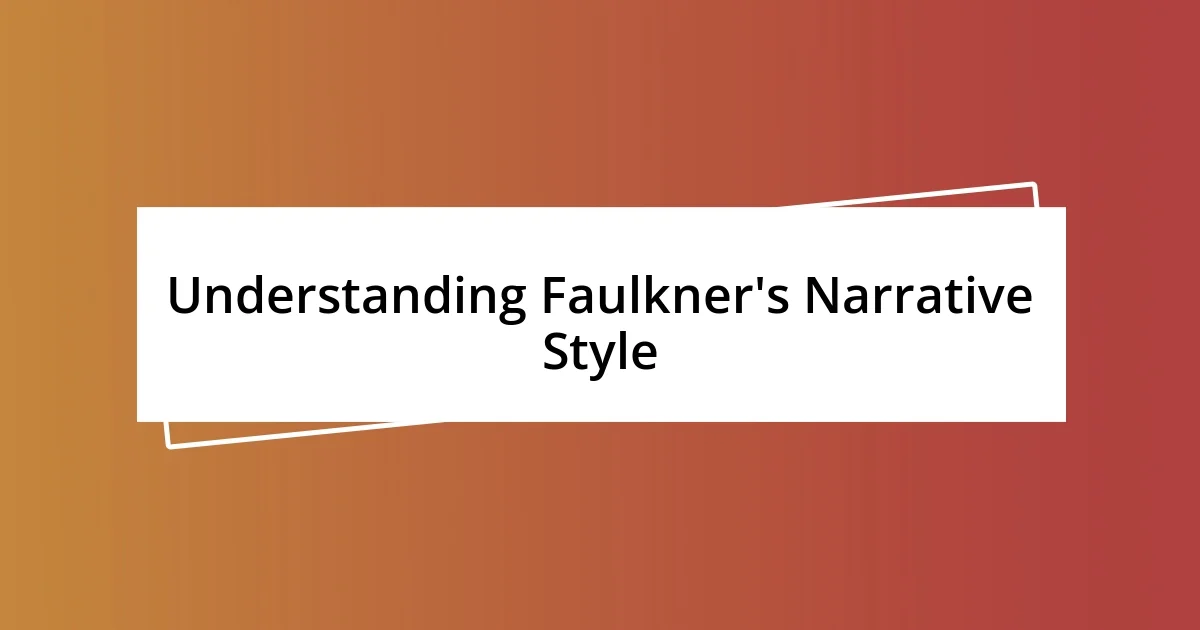
Understanding Faulkner’s Narrative Style
Faulkner’s narrative style often feels like a winding river, moving through time and memory. His use of stream-of-consciousness can be disorienting at first—I’ve found myself rereading passages, trying to catch every nuanced thought. Isn’t it fascinating how a single moment can ripple out to reveal the complexity of a character’s psyche?
What truly captivates me about Faulkner is his layering of perspectives. In “The Sound and the Fury,” we see events unfold through the eyes of different characters, each offering a fragment of truth. Have you ever experienced a situation where multiple viewpoints changed your understanding? I’ve encountered this in discussions with friends, where a shared memory reveals completely different emotions based on our individual experiences.
There’s also a rhythmic, almost musical quality to Faulkner’s prose. I remember feeling swept away by the lyrical flow of his sentences, like listening to a haunting melody. How does one approach a text that’s both beautiful and bewildering? It takes patience and a willingness to embrace the ambiguity that defines much of his work. Just like life, his narratives often don’t provide neat conclusions, inviting us instead to reflect on the messy reality of human existence.
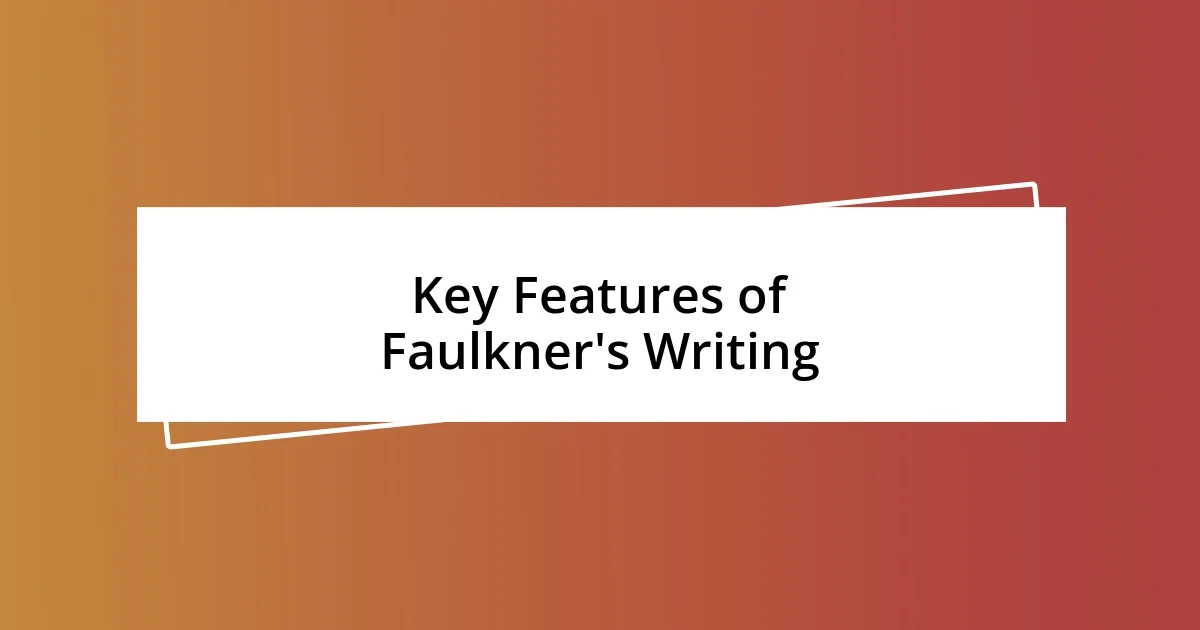
Key Features of Faulkner’s Writing
Faulkner’s writing is intricate, much like a tapestry woven with threads of memory and emotion. He plays with time, often jumping around chronologically, which can be jarring but also allows for a deeper exploration of themes. I remember the first time I puzzled through “As I Lay Dying”—the shifting timelines left me feeling both challenged and exhilarated, as if I were piecing together a complex puzzle that revealed more of the characters’ inner lives with every twist.
Here are some key features of Faulkner’s writing:
- Stream-of-Consciousness: This technique mimics the natural flow of thoughts, providing insight into characters’ minds.
- Multiple Perspectives: He often tells the same story from different viewpoints, enriching the narrative with diverse interpretations.
- Non-linear Chronology: Events unfold out of order, emphasizing memory’s fluidity and reflecting the chaotic nature of human experience.
- Rich, Descriptive Language: Faulkner’s prose can be lush and poetic, evoking strong imagery and emotions that linger long after reading.
- Themes of Isolation and Complexity: His characters often grapple with their identities and relationships, making their struggles feel universal and deeply relatable.
I recall how I was drawn into the emotional depth of “The Sound and the Fury.” Each character’s narrative was like a door opening to a private world, revealing how disparate experiences can converge to illustrate a family’s story—it’s something I often reflect on when engaging with my own family history.
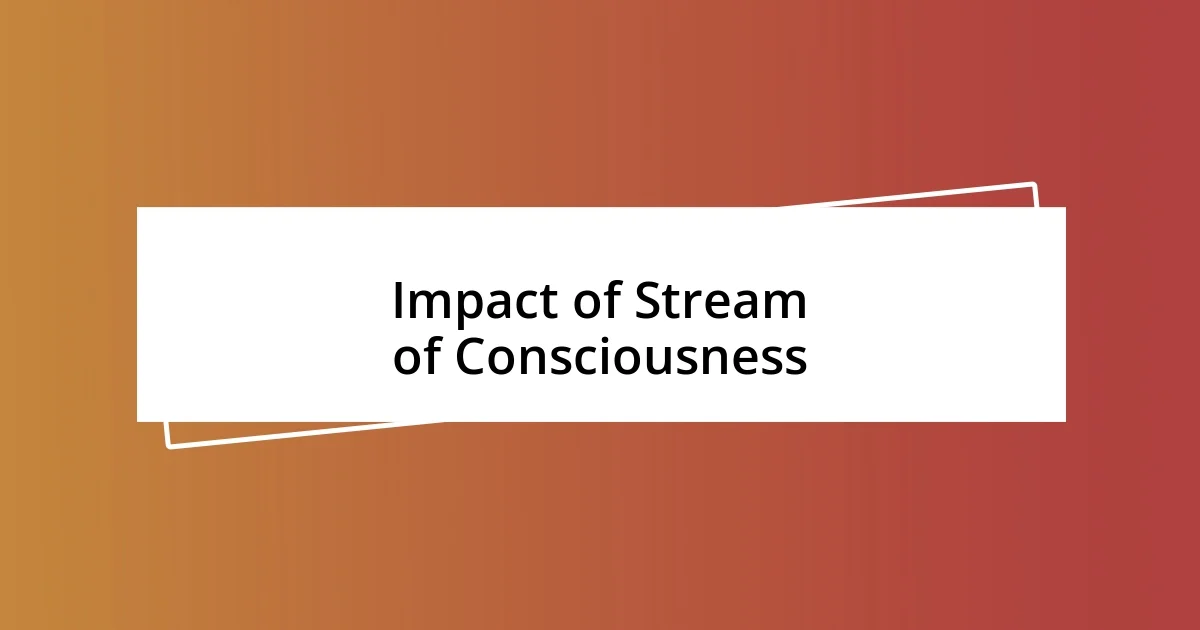
Impact of Stream of Consciousness
The impact of stream of consciousness in Faulkner’s work is profound, as it allows readers to enter the tumultuous inner worlds of his characters. I remember being particularly struck by this technique in “Absalom, Absalom!”—the jagged shifts in thought and time mirrored the chaotic nature of memory itself. It’s a visceral experience; one moment you’re immersed in a character’s anguish, and the next, you’re swept into their fleeting reminiscences, creating a rich emotional tapestry that resonates deeply.
In my readings of Faulkner, I often find myself reflecting on how stream of consciousness reveals not just plot but deep-seated emotions and conflicts. This narrative style can evoke a sense of empathy that draws you closer to the characters. For instance, the feelings of loss and longing expressed through Quentin Compson’s thoughts in “The Sound and the Fury” linger in my mind long after I’ve put the book down. Have you ever read something that felt like it echoed your own struggles? That’s the beauty of Faulkner’s approach; it allows us to confront complex feelings in a relatable way, showcasing the human experience’s nuances.
The effectiveness of this technique lies in its ability to blend thought and narrative, creating a rhythm that can be both beautiful and unsettling. I find Faulkner’s prose often captures a moment in time so vividly that it lingers in my thoughts. While it may take a few readings to grasp fully, the richness of emotion embedded in these streams makes that effort worthwhile. I often think about how this reflects our own chaotic thoughts—a blend of emotions, memories, and fleeting ideas that defines our daily lives.
| Stream of Consciousness Technique | Impact on Reader |
|---|---|
| Mimics natural thought flow | Enhances emotional engagement |
| Shifts in time and perspective | Creates a multi-layered understanding |
| Conveys deep inner turmoil | Fosters empathy for characters |
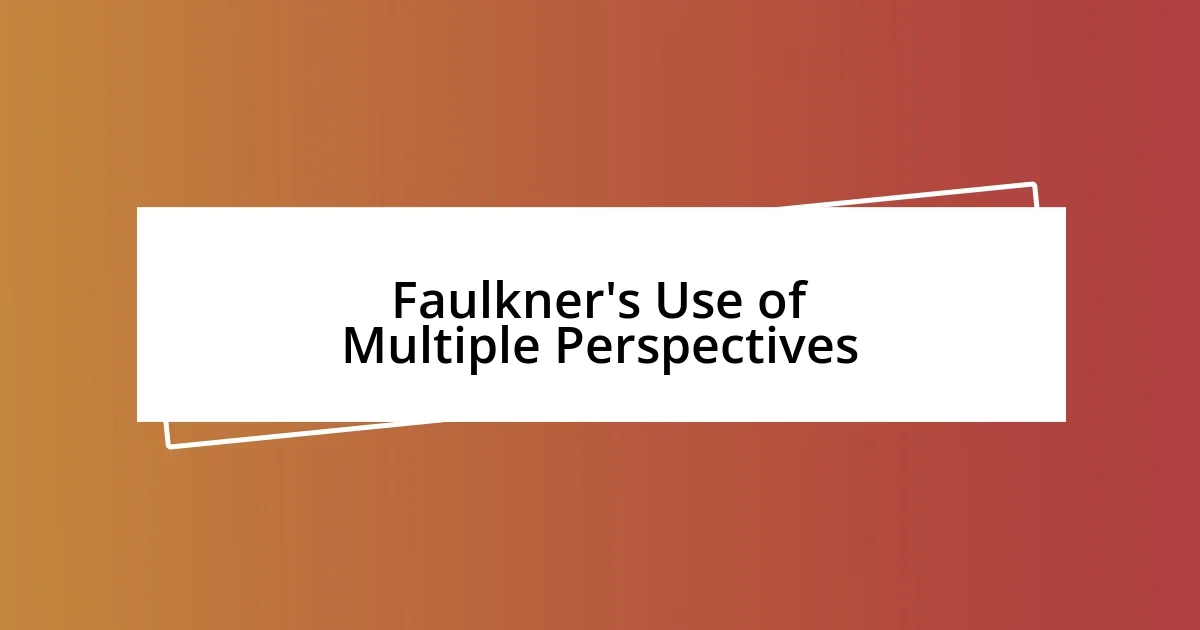
Faulkner’s Use of Multiple Perspectives
Faulkner’s use of multiple perspectives is one of the most fascinating aspects of his storytelling. I still vividly remember my first encounter with “The Sound and the Fury.” Each character’s voice felt distinct, almost like attending a family reunion where everyone has their own version of the same event. This narrative technique allows readers to step into different shoes, providing a richer understanding of the characters and their intertwined fates. Have you ever wondered how our perceptions shape the stories we tell?
When I think about how Faulkner crafts his narratives, I’m struck by the way he allows readers to see events from divergent angles, sometimes leading to conflicting interpretations. In “Absalom, Absalom!” for instance, the various accounts of Sutpen’s life weave a complex picture of ambition and tragedy. It’s like piecing together a jigsaw puzzle where one piece can dramatically alter the entire scene. The emotional weight really hits home when the characters reflect on their shared histories while interpreting them in contrasting ways. It makes me question how often we let our personal biases color our understanding of shared experiences.
This intricate layering of perspectives not only enhances the storytelling but also invites readers to engage in the narrative actively. As I read, I often find myself wrestling with my own judgments and feelings about the characters. What resonates most with me is how Faulkner highlights the messiness of human relationships and memory. When different characters recount the same story yet offer varying insights, it mirrors how we navigate our own lives—our beliefs and emotions often in flux. Doesn’t it make you think about how we recount our stories differently, based on who we are and what we’ve been through?

Analyzing Character Development Techniques
Analyzing character development in Faulkner’s work reveals a unique approach that transcends traditional storytelling. I often find myself captivated by how he crafts his characters’ psyches, allowing their motivations and complexities to unfold organically, almost in real-time. For example, the internal struggles of characters like Benjy in “The Sound and the Fury” exemplify this, as their fragmented thoughts create a raw, emotional connection that feels almost intimate. Have you noticed how our own struggles often come out in the most unexpected ways?
Faulkner’s ability to intertwine dialogue with inner monologues is what, in my view, fuels character growth. It’s as if I’m eavesdropping on their deepest thoughts while witnessing their external conflicts. A moment that sticks with me is when Caddy’s name elicits a surge of emotion in several characters, revealing their relationships and the burdens they bear. This interplay not only develops their personalities but also invites us to empathize deeply. It’s intriguing how characters can be shaped by their interactions while still remaining enigmatically themselves, don’t you think?
Moreover, I appreciate how Faulkner often uses a non-linear timeline to enhance character depth. When I navigated through “Absalom, Absalom!”, the disjointed structure forced me to re-evaluate my understanding of each character’s journey. By teasing out their backstories and exposing their vulnerabilities piece by piece, I felt more connected to their fates. It made me ponder how our own histories shape our identities. Isn’t it amazing to realize that just like Faulkner’s characters, our pasts are woven into the very fabric of who we are?

Themes Reflected in Narrative Style
Faulkner’s narrative style reflects themes of memory and trauma in deeply compelling ways. I often ponder how our recollections can shift and change over time, much like the characters in “The Sound and the Fury.” When Benjy’s fragmented memories unfold, it feels like I’m peeling back layers of a shared experience, revealing the deep scars that influence his present. It leaves me with the question: how does our understanding of the past shape our reality today?
The theme of communal history also shines through Faulkner’s storytelling technique. I remember being struck by the collective burden shared by the characters in “Absalom, Absalom!” The fragmented narratives echo the weight of their shared legacies, showing how family history can bind us together while simultaneously tearing us apart. It’s fascinating to consider how our own family stories impact our behaviors and relationships. Have you ever felt the lingering echoes of your family’s past in your own life?
Another compelling theme reflected in Faulkner’s narratives is the exploration of identity and self-perception. When I read “Light in August,” the character of Joe Christmas serves as a poignant reminder of the complexities surrounding identity. His struggle with racial ambiguity and personal belonging resonated with me, triggering reflections on my own sense of identity. How often do we wrestle with who we are based on the perspectives others hold? It’s a thought-provoking reminder that our sense of self is often a mosaic of perceptions and experiences, much like the narratives Faulkner beautifully weaves together.
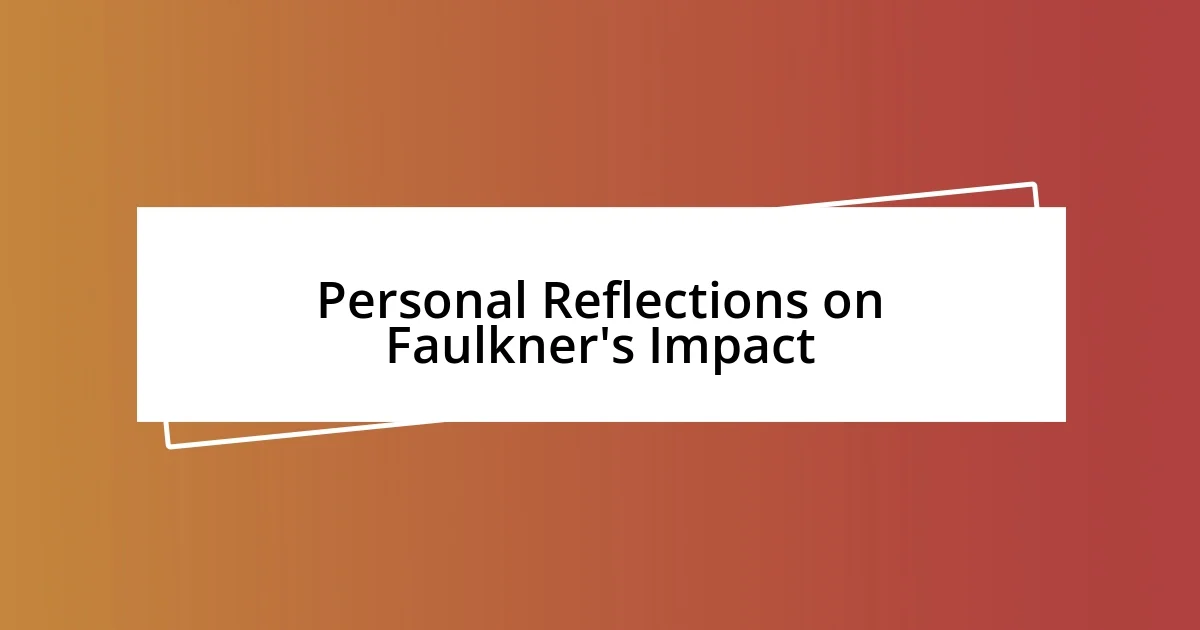
Personal Reflections on Faulkner’s Impact
Exploring Faulkner’s impact on narrative style always stirs my thoughts about the profound layers he weaves into storytelling. When I first encountered “As I Lay Dying,” the idea of multiple perspectives truly resonated with me. Each character’s voice felt like a glimpse into their soul, revealing their unique truths, which made me reflect on how we all interpret experiences differently. Isn’t it fascinating how a single event can be viewed through countless lenses, offering a kaleidoscope of emotions?
There’s something remarkable about how Faulkner challenges readers to engage actively with the text. I remember almost feeling overwhelmed by the intricate language and structure of “The Sound and the Fury.” Yet, as I persevered, I discovered a sense of fulfillment that comes from piecing together the narrative puzzle. It dawned on me that, much like life, understanding often requires grappling with chaos. Don’t you think that sometimes, the struggle to make sense of something can be just as valuable as the clarity we seek?
Faulkner’s influence on literature is undeniable, particularly in how it encourages introspection. When I finished reading “Light in August,” I found myself questioning my understanding of identity and humanity. The raw honesty in his characters’ struggles prompted me to examine my own beliefs and biases. How often do we confront our perspectives and the narratives we’ve built around ourselves? It makes me appreciate the power of storytelling—not just to entertain but to challenge and transform.














